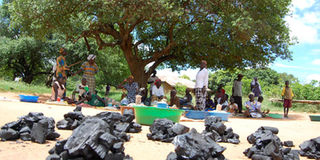Prime
What made the prices of charcoal soar?

Women sell mounds of charcoal in Payira trading centre, Alwi Sub-County in Pakwach. Each mound goes for Shs500 The prices of charcoal have in the recent past risen to staggering levels. Photos by Stephen Otage.
Not more than a month ago, the price for a sack of charcoal had shot to the heights of Shs80,000, creating a hitherto unfathomable situation where it was more affordable for families to buy gas than charcoal. The price has since started falling, now averaging between Shs50,000 and Shs60,000, depending on which parts of the city you buy it.
But as the price was at Shs80,000 per sack in Kampala, charcoal makers back in the forests were selling the same at an average price of Shs30,000 per bag to traders, who then delivered the charcoal into town. That would leave a Shs50,000 gap into which all kinds of middlemen and profit-seeking traders would eat into.
This year’s unprecedented rise in charcoal prices is as a result of an unfortunate combination of natural forces, heavy rains and lengthy dry seasons, an increase in costs of production, and, a subtle but highly influential hand of profiteering businessmen.
The search for the leading source of charcoal consumed in Kampala and its neighbourhood led to the jungles of Luweero-Triangle, to Kyankwanzi in Kiboga district and Nakaseke district. But it is Ngoma town, in the northern parts of Nakaseke, bordering Masindi district, which most traders interviewed pointed out as the biggest supplier of charcoal. There, a representative of the charcoal makers, told of how this year’s rains plus the timely increase in fuel prices, forced charcoal makers to hike their prices.
“The biggest problem that has caused charcoal to become very expensive is that charcoal is seasonal,” says Mr George William Kataate, the head of charcoal makers in Ngoma town. “When it rains, trucks have nowhere to pass. The roads are completely spoiled and become impassable. People with trucks, who had brought them to collect charcoal, find them trapped in the mud. Those people find themselves having to send for mechanics to come and repair their trucks. All those are extra costs, which the traders had not planned for but which they face and have to recover because they are doing business,” Mr Kataate adds.
The road network in Ngoma, save for the main murrum highway, which leads on to Masindi, and, the one that heads to Kiboga, is at the mercy of the rains, with entire breadths of the road cut off either by water, or made barely navigable by slippery or thick mud conditions.
“A time came when trucks were caught here, spoiled in the bad roads, and none was going back to Kampala. Those in Kampala could not come because they feared the bad roads. As a result, there was scarcity of charcoal in Kampala. The few that had charcoal took the opportunity to hike the prices for the charcoal,” Mr Kataate explains.
He says this situation hit a peak sometime around August going on to September. However, the high prices for charcoal were biting in Kampala way before August. The charcoal maker says that although extreme rainy conditions are bad for charcoal traders, extremely hot conditions, the kind that were prevalent before August, are also bad for charcoal makers because they harden the soil and complicate the act of cutting soil to create a kiln.
Mr KataaProfiteeringte says that in normal conditions, and before the prices went berserk, charcoal makers sold the charcoal at Shs12,000 per bag. But by September this year, that price had risen to Shs30,000.
And it is with that set of conditions that you add the highly flammable factor of high fuel prices. In fact, the fuel prices were already high by the time the most recent rain season came. But that combined with the rains, added another barrel to the charcoal price gun. The combination of fuel costs and bad weather also explains why the prices went so high this year, unlike what has been seen before.
Mr Kataate says that when the roads became impassable, traders raised the price of transporting a single bag of charcoal to Kampala from Shs6,000 to Shs10,000 per bag. But that would, at the very least, seem like a very modest estimate. Charcoal trade middlemen interviewed in Kampala, said they were now selling a sack of charcoal to retail sellers at a minimum of Shs40,000, having bought it at Shs18,000 from the makers in the jungles. That would leave a Shs22,000 extra on the bag, from when it was let go by the makers, as a transport charge. All this at a time when the prices are starting to decrease.
Charcoal middlemen said that at the height of the price rise, it cost between Shs35,000 and Shs40,000 to buy a sack from the charcoal makers. They would then sell the same at Shs60,000 to Shs65,000 to retailers in Kampala. That would leave a Shs25,000 charge as transportation fee.
Profiteering
Retail traders have probably played a role too in pushing the prices high. Mr Mugisha, a charcoal trader in Kisenyi, down-town Kampala, says, retail traders raised the cost of their charcoal because the costs of living had gone up too. “Everything is expensive now. The person who is well placed is the one who has something to sell. I have charcoal. I add just something small to help me afford what I need,” he says. “Even the supply was very low. The price of charcoal was high but the charcoal was bought off very fast.”
Another form of an increase in running costs in charcoal production is the setting in which the charcoal makers operate. Mr Kataate explains that there is hardly a viable road network to the exact spots where the charcoal is made in Ngoma. The truck drivers find themselves going through farms, which makes driving through a hardship, but also, creates another difficulty in the form of farm owners who demand levies on the trucks. “So, you might find a trader having to pay anything, even Shs50,000 for a farm owner to allow them pass their truck through the farm,” Mr Kataate says. Charcoal makers have had to go deeper into the jungles in search of charcoal viable trees because the accessible areas have been depleted.
Rains continue, prices fall
After listening to the causes of the increment in charcoal prices, it hits you as surprising that as the rain season seems to be kicking into a new gear of life, the prices for charcoal are slowly descending back into normalcy. Mr Kataate says we will have to wait to see what effect the current spell of rains will have on the prices. Mr Mugisha, however, cites this as the very factor why charcoal prices could abandon their fall and generate into a new hike, all the way to even higher than Shs100,000 per bag. Listening to him talk, it was hard to discern whether he made the deductions as a careful study of the market’s trends, or, as a ravenous profit-minded trader.
That three-month period when charcoal prices skyrocketed through the roof also offers an opportune moment to reflect on our dependence on charcoal as a fuel. During that time, demand for gas also shot through the roof as many consumers turned to gas because it was not only cleaner, but had also become cheaper than charcoal. Could that be a sign of a shift in a paradigm?
The Food and Agriculture Organisation (FAO) says that by 1994, Uganda was producing 400,000 tonnes in 1994. The then Ministry of Water, Lands and Environment had put that figure at 500,000 tonnes for the year 2000 and by 2010, FAO says that we were producing 906,579 tonnes of charcoal per annum. Data from the Ministry of Water and Environment stated in 2009 that by 2020, Uganda could be importing wood fuel, having run out of its own reserves, a damning prospect for a country with so much greenery. The charcoal price crisis could have been the real-life example Ugandans were waiting for to learn that they can actually do without charcoal, and in turn, do the environment some good.




